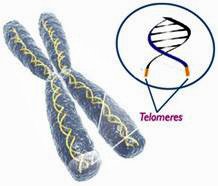Telomeres and Swimmers Go Hand in Hand
Telomeres may be a new term to you. These are aligned with the chromosomes of your body, at their ends. They are made up of a DNA sequence that repeats itself. While this repetition is usually only 3,000 times, some people have been shown to have 15,000 repetitions of TTAGGG appear. When the telomere is healthy, they help to maintain the chromosomes within the nucleus. They also protect the end of the chromosomes, so they are not as easily attacked. As we age, the telomere will divide and the end replication can lose about 25 bases off the end. With oxidative stress, and an unhealthy lifestyle, this can occur more rapidly, that is why it is critical we diet and exercise.
Below picture from:
www.beltina.org/health-dictionary/telomere-definition-structure-dna.html

Short telomeres are unable to replicate, and they can cause the cell to die. When this happens, the cell enters apoptosis or a form of cell death. The death of these cells actually causes us to age. While it is good to have these cells for that, they aren’t unique to healthy cells. Scientists have found cancer cells also have telomerase and it is possible that by attacking them, new treatments for cancer research can become available in the near future.
Telomeres and the Fountain of Youth Syndrome
So the secret to fighting aging, is to keep your many telomere long. When you do this, you have an internal fountain of youth that will help you to keep looking young and beautiful for years to come. Perhaps the two best ways to do this is to swim and to focus on good nutrition.
When you exercise at moderate levels, your telomeres will naturally increase. Swimming is quite possibly one of the best forms of exercise for your body. Swimmers who are active in the water for at least 100 minutes each week at a moderate pace, will have the same level of telomere length as someone who is three years younger than them. However, swimmers who exceed three hours of moderate exercise in the water, found that they had the same telomeres as someone almost a decade younger than them. The thing was, when the exercise of a person increased, so did the telomeres.
Not sure what a moderate pace looks like? It is when swimmers maintain a heart rate of over 100 beats per minute. This range is the best to keep your body moving actively, and to ensure you are maximizing the benefit of the exercise when you are in the water.
Nutritional Importance
Of course, swimming is just a portion of what you need to do. Swimmers find that when their moderate exercise levels are combined with a healthy diet, they see even better results. The diet is one that will also reduce your risk of cancer, slow down aging, and can help you to build additional lean muscle and that desirable swimmers body. This includes boosting antioxidants and fiber, while taking in soy protein and healthy fats such as those found in nuts, fish, and avocados.
By doing all this, you should find that you continue to have a vibrant and youthful look. You’ll also find that you improve as a swimmer and have the extra bonus of building healthy, lean muscle that will allow you to feel better too.
Today’s Swimming Workout
Warm-up: 500 straight one stroke, 100 breaststroke kick, 300 Individual Medley, 100 butterfly kick on your back
Kick with swim fins: 400 flutter kick on front and back
Drill: 400 alternating static front balance and swimming long breathing every stroke on your side
100 Individual Medley
Pull: 25 breaststroke, 75 freestyle, repeat until you reach 600
Kick 400 Indivdual Medley
100 backstroke, 2 x 50 freestyle, 12 x 25 alternating backstroke and freestyle
Warm-down: 400 choice of swim stroke - tai chi style
Total: 3800 meters or yards depending on the length of your pool
back to the top of telomeres page








